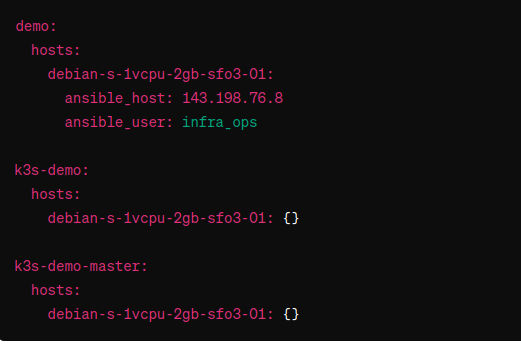Learn more about Ansible Dynamic Inventory DigitalOcean. Our DevOps Support team is here to help you with your questions and concerns.
Ansible Dynamic Inventory DigitalOcean
In the world of infrastructure automation, managing Ansible inventory efficiently is key for smooth deployment and configuration management.
Ansible offers two primary methods for defining inventory: static and dynamic. Let’s explore both approaches and understand their implications.
Creating an Ansible inventory starts with manually defining hosts, groups, and variables in static files. Although dynamic inventory offers flexibility, starting with a static configuration results in a better understanding of inventory management.
Static Inventory: The Traditional Approach
Static inventory includes hardcoding hosts, groups, and variables into static files. While this method is straightforward, it can become difficult to manage, especially in dynamic environments where hosts may change frequently.
Declaring Static Host Groups and Variables
In a static configuration, host groups and variables are explicitly defined in inventory files. For instance, DigitalOcean Droplets can be grouped based on tags and assigned static host variables like `ansible_host` and `ansible_user`.
For example, here is a static inventory definition for a DigitalOcean Droplet:

While static inventory provides a clear structure, maintaining it can be difficult.
Dynamic Inventory: The Modern Alternative
These plugins in Ansible help interface with cloud providers, local hypervisors, or other host-management solutions to map the current state of hosts into Ansible’s inventory format.
Dynamic Inventory Plugins
With dynamic inventory plugins, Ansible can automatically fetch host information. These plugins can be configured to get hosts based on tags, regions, projects, and more.
Here’s an example of configuring the DigitalOcean inventory plugin:

Dynamic inventory offers scalability and automation benefits, making it ideal for dynamic infrastructures where hosts are provisioned and decommissioned frequently.
While static inventory offers simplicity and control, dynamic inventory offers scalability and automation advantages. Choosing between the two depends on factors like infrastructure complexity, frequency of changes, and automation requirements.
Dynamic inventory plugins help with seamless integration with cloud platforms. They also offer up-to-date inventory management. However, static inventory is still useful in smaller, static environments.
[Need assistance with a different issue? Our team is available 24/7.]
Conclusion
In brief, our Support Experts introduced us to Ansible Dynamic Inventory in DigitalOcean.
PREVENT YOUR SERVER FROM CRASHING!
Never again lose customers to poor server speed! Let us help you.
Our server experts will monitor & maintain your server 24/7 so that it remains lightning fast and secure.





0 Comments